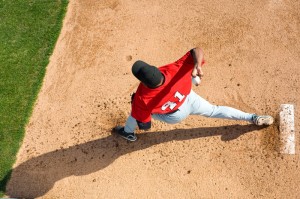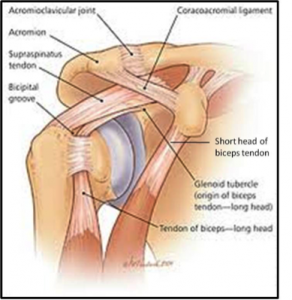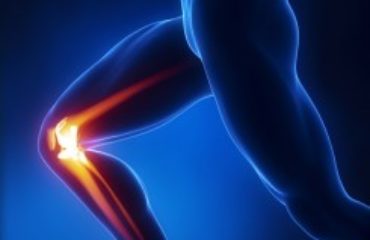The biceps tendon attaches the biceps muscle to the shoulder and arm bones. If you tear the biceps tendon at the shoulder region, you could lose arm strength and experience pain. While many people can still function with a biceps tendon tear at the shoulder, surgery is required for complete recovery of strength and mobility
What structures make up the shoulder and arm?
The biceps tendon attaches at two sites at the shoulder joint. The shoulder is a ball-and-socket joint made of three bones: the scapula (shoulder blade), the humerus (upper arm bone), and the clavicle (collarbone). The head of the
humerus fits into a socket in the shoulder blade, which is called the glenoid. The rotator cuff is comprised of many muscles and tendons that keep the arm bone in the glenoid. The upper portion of the biceps muscle has two tendons, which attach the biceps muscle to the shoulder region.
What is the difference between a partial tear and a complete tear?
Biceps tendon tears may be partial or complete. With a partial tear, the tendon is not severed into two pieces. A complete tear means the tendon is split into two separate pieces. For some patients, the tendon starts with a partial tear (fraying) which progresses to a complete tear as damage progresses.
What causes a biceps tendon tear at the shoulder?
The two main causes of a biceps tendon tear are injury and overuse. The biceps tendon can be torn at the shoulder from a fall onto an outstretched arm, or when you lift something that is too heavy. Many tears at this area come from overuse, which is using the same shoulder motions over and over again and repeating the same maneuvers. Overuse can lead to rotator cuff injuries, tendinitis, and shoulder impingement. Having one or more of these conditions puts stress on the biceps tendon, which makes it have increased risk for tearing.
How common are biceps tendon tears at the shoulder?
Ruptures of the long head of the biceps represent 96% of all biceps tendon tears. This injury affects men more than women, and is more common among those aged 40-60 years. However, this injury is also linked to many sporting events.
What are the risk factors for a biceps tendon tear?
Risk factors include:
- Advanced age – Older people are more at risk because of the wear-and-tear on the tendons.
- Shoulder overuse – This includes overhead sports, such as tennis or swimming.
- Smoking – Nicotine affects blood flow to the tendons.
- Corticosteroids – Use of corticosteroids can cause tendon weakness.
What symptoms are associated with a biceps tendon tear of the upper arm?
The symptoms include:
- A sudden pain of the upper arm
- Hearing an audible snap or pop

- Cramping of the arm muscle with strenuous arm usage
- Bruising from the upper arm down toward the elbow
- Tenderness at the shoulder area
- Shoulder weakness
- Decrease in supination strength (turning palm up and down)
- Bulge of the middle arm with a dent toward the shoulder
How is a biceps tendon tear at the shoulder diagnosed?
The diagnosis of a biceps tendon tear is made based on symptoms and medical history. The sports medicine doctor in Phoenix will have you move the arm through normal range of motion, palpate the shoulder and arm regions, and ask you to bend and tighten your biceps muscle. X-rays are often used to rule out other problems associated with shoulder and arm pain. The magnetic resonance imaging (MRI) scan will show both partial and complete tears.
How is this type of biceps tear treated?
For many patients, the pain of a partial biceps tendon tear resolves with time. Older and less active people may not be concerned about mild arm weakness. However, young, active individuals usually chose to have surgery to repair a torn biceps tendon. Treatment options include:
- Rest – Avoidance of heavy lifting and any overhead activities to decrease swelling, allow healing, and alleviate pain.
- Ice – Apply ice packs for 20-minute intervals several times each day.
- Nonsteroidal anti-inflammatory drugs (NSAIDs) – These drugs reduce pain and swelling. Examples are ibuprofen, naproxen, and ketoprofen.
- Physical therapy – Strengthening and flexibility exercises are used to restore movement and to strengthen the shoulder.
- Surgery – Surgery is used for patients whose symptoms are not relieved with nonoperative measures, or for athletes who wish to regain strength and arm/shoulder motion. The procedure involves a few incisions around the shoulder region. The surgeon reanchors the torn tendon back to the bone. If necessary, the Phoenix orthopedic surgeon will use a graft to replace the torn tendon. The tissue is reattached to the bone using anchors, sutures, and wires.
What is rehabilitation after surgery like?
After your biceps tendon tear repair surgery, your shoulder and arm will be immobilized in a sling. You must start physical therapy soon after surgery, which involves gently range of motion exercises. After a few weeks, the therapist has you do strengthening exercises. Full recovery may take 4-5 months.
Dr. Adam Farber at Phoenix Shoulder and Knee offers expert treatment for all types of biceps tears. He is Board Certified and highly skilled, call today!
Resources
- J. Nho, E. J. Strauss, B. A. Lenart et al., Long head of the biceps tendinopathy: diagnosis and management. Journal of the American Academy of Orthopaedic Surgeons, vol. 18, no. 11, pp. 645–656, 2010.



